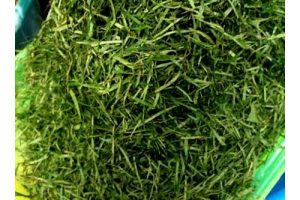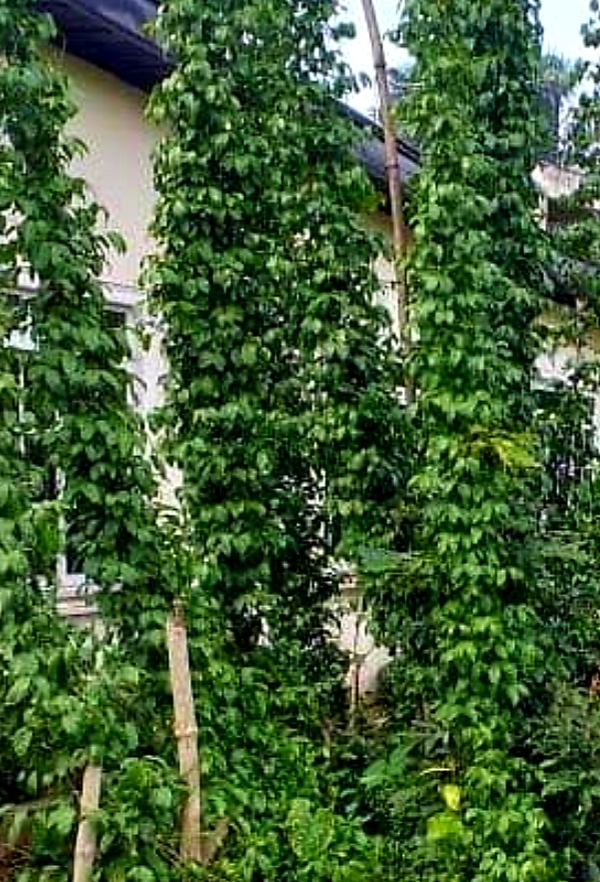It’s Preferred Common Name is: Afang and may go by other names in different languages.
Origin Of Afang
Gnetum africanum, commonly called afang by the Efik/Ibibio tribe of southern Nigeria, is a vine gymnosperm species in the genus Gnetum native to tropical Africa.
Afang is characterized by its naked seeds. It originates from Africa and is mostly planted and consumed in southern Nigeria.
Traditionally, gnetum africanum is considered a wild vegetable with a wild vine.
It is an evergreen plant that grows up to 10 meters in height, with thick green ppapery-like leaves growing in three groups.
Leaves may grow up to 8 cm long and produce small cone-like reproductive structures at maturity.
The plant’s vine is a climbing one; hence stakes are used to support the vine.
The vine seeds look like fleshy fruit; they are red-orange when fully ripe and are 10-15 mm x 4-8mm in size.

The plant leaves are usually the consumed part, and are sold in the market, and used to prepare soups and stews or even eaten raw.
Medicinal Properties and Uses Of Afang
To know more about afang, and how it can be used, is outlined below:
- Afang leaves is considered herbally medicinal and can be used to treat nausea, sore throats, or dress warts.
- You can eat the plant’s stem for medicinal purposes, such as reducing pain during childbirth.
- Afang contains protein, and it is very rich in essential and non-essential amino acids. These nutrients help recovery after surgery, tissue repair, and athletic performance.
- It is also used to treat piles and high blood pressure and as medicine against enlarged spleen, sore throat, and as a purgative.
- The leaves are eaten to treat nausea and an antidote to arrow poison made from Periploca nigrescens Afzel in the Central Africa Republic.
- Afang leaves are taken as an enema against constipation, for easy childbirth, and to reduce of effects of alcohol in Cameroun. They can be used to treat boil and fungal infections on the fingers.

- Lastly, afang is a delicacy, and one of two most popular fulfilling soups in southern Nigeria. It is fondly called the “king of soups”.
How To Grow Afang and Level of Yield
To grow Gnetum africanum below are what you need to know:
Afang produces a high yield of leaves used for soups. It has been observed that during the first year of cultivation, the fresh leaf may yield up to 20 tons per hectare. This quantity may multiply in subsequent years.
Nursery And Transplant Requirements Of Afang
Gnetum africanum is vegetatively propagated using its leafy stem cuttings; however, there has been a recent development in which it is highly recommended that blades be trimmed in half.
Propagation on the nursery bed should be under shade and comprises long-aged sawdust or fine river sand.
The rooted cuttings are transferred to polythene sleeves, bamboo pots, or other containers after about six weeks, and they will remain there for about 2-3 months.
The soil should be made up of 25% sand and some compost, supplemented with forest soil.
Planting on the field takes place at the beginning of the rainy season.
Soil, Sun, And Watering Requirements Of Afang
Gnetum africanum will thrive optimally in every soil with plant nutrients.
It requires full sun exposure, explaining why it sprouts at full capacity during the dry season. It prefers moist soil for its growth.
Afang requires moderate watering; overwatering will lead to fruit rot.
Harvesting Of Afang
The prevalent harvesting method, especially for export, is pulling the stems or branches from the trees.
This method destroys the natural stands. Sometimes, the trees are cut to reach the leafy stems in the canopy.
Controlled harvesting is ideal in that only side of the shoots are collected.
New shoots may develop where a stem has been cut, or side shoots removed in controlled harvesting.
It has been observed that 3-4 harvests per year are possible, and the plant will still regrow well.
Frequent harvesting will cause the leaves to be thin, and they will be considered inferior. The first harvest may take place 6–9 months after planting. The total lifespan of afang is estimated at over ten years.
Disease And Pest Of Afang
Mealybugs are the major pest affecting the plant in the nursery. When gnetum africanum is grown along dead poles attacked by termites, these insects will damage adjacent leaves.
Diseases have not been found to reduce the productivity of gnetum africanum. It is a one of a kind plant that has strong immunity over most diseases that affect other crops.
Conclusion
Afang, is an interesting plant with qualities that keeps it on the top of most leafy greens. When made into a soup, you can be sure of a mouthwatering meal.
Planting and harvesting may need some form of skill to achieve the desired results by amateur hands.
